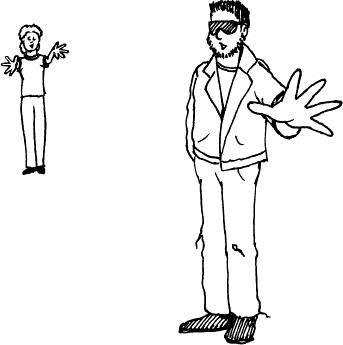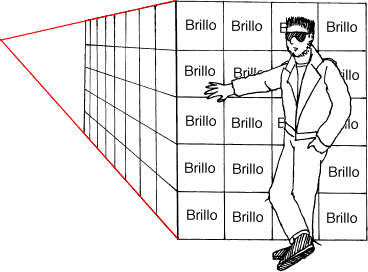
Return to the Perspective Menu
|
The Linear Basics
Linear perspective has a few broad and all encompassing
rules with many specific and exacting applications. By
learning these rules along with a few of the specific
applications, an artist can pick and choose just how
exacting a flat image will appear in depth and scale.
To understand these rules, we will first need to
highlight and explain some basic concepts. Many of these
will seem obvious, while others may appear contrived for the
sake of discussion and measurement.
|
For opening concepts we will need to deal with the concepts of
diminution, convergence, and foreshortening.
Each of these ideas intersects the other in part of their meaning, so
it is probably simplest to lump them al together.
Diminution is the concept that the farther something is
from us, the smaller it appears. It is quite obvious when we look for
it, but our brains are so good at interpreting our visual
experiences, that we hardly notice he effect unless we dwell on it.
Mountains far away appear smaller than rocks up close, and the same
person who appears six feet tall when standing right next to us might
appear only six inches tall when standing on the other side of a
large room. Our ability to interpret our environment sometimes gets
in the way of our understanding, but as an artist we must always be
aware that true size is not always the same as perceived size.
Convergence is the idea that although parallel lines never
actually meet, they will appear to meet converge at a point that is
far away from us. We will later call the place where they seem to
meet a vanishing point. This is actually a sort of corollary to the
principle of diminution. Eventually parallel lines can get far
enough away from us that the space between them becomes to small to
see. What linear perspective does with this is actually quite simple:
it assumes that the rate of shrinkage due to distance is constant and
measurable. It is the particular angle measurements that can get
confusing.
Foreshortening is the basic idea that as objects rotate in
space, different parts of them become closer to and farther from the
observer. Therefore, the concepts of diminution and
convergence will apply not only to individual shapes, but to
different parts of the same basic shape. This is perceived as warpage
of an image as it is seen at different angles. Our brains, powerful
as they are, allow for this on a constant basis so we do not have to
constantly concentrate on reinterpreting our surroundings every time
we or it moves.
Some Examples
Meet Candy and Spike. They will be helping us illustrate the
nuances of our concepts.

In the above image, both Candy and Spike appear to be of a similar
height. Even though they are just cartoon outline people, we make
certain visual assumptions about them automatically. The main thing
that our brain registers about them visually is that they are about
the same size and therefore the same distance from us.

Now the image of Candy has been shrunk. Since we assume that most
people should be of a similar size, she appears farther away from us
than Spike does. The fact that her head is at the same level as
Spike's and that her feet are not also enhances this illusion. Candy
is a victim of diminution. Because her image is roughly half
the height of Spike's, we understand that she is about twice as far
from us than he. If Spike were ten feet from us, Candy would have to
be about twenty.

Here the image of Spike has been enlarged slightly, making him a
step or two closer to us. Notice how the hand that he waves in our
direction appears enlarged, making it look even closer still. Candy,
is likewise protruding her hands toward us, but hers do not appear
oversized. If we now assume that Spike is about eight feet from us
and that his reach is around three feet, that places his hand about
five feet away (8-3=5) from us. His hand is about 38% closer to us
and has been enlarged accordingly. If Candy is still twenty feet
away, her hands then are only 15% closer to us, and the size change
is relatively small.
Cameras can seem to bring us closer to a subject by enlarging the
perceived image, but they cannot allow for relative ranges of
diminution. This is the key reason why photographs, especially
long range ones, tend to flatten perspective.

When objects become so diminutive that we can no longer see them,
they vanish. Since the rate at which objects shrink in relation to
distance is constant, we can describe their rate of diminution
with straight lines across the flat visual field. These lines are
known as lines of perspective and they meet where we would cease to
be able to see an object if it continued all the way into the
distance. This concept is less obvious than diminution because we
assume that parallel lines will never meet. By definition they will
never meet, but visually they do converge at a distant
point.

 Simple
objects like cubes and cylinders are rather easy to draw using the
basic rule of convergence. More complex and compound shapes
may cause some difficulty, but even with relatively flat drawings a
feeling of depth can be created if we remember that lines of
perspective show a rate of diminution by showing where
parallel lines converge.
Simple
objects like cubes and cylinders are rather easy to draw using the
basic rule of convergence. More complex and compound shapes
may cause some difficulty, but even with relatively flat drawings a
feeling of depth can be created if we remember that lines of
perspective show a rate of diminution by showing where
parallel lines converge.
With or without strict linear perspective, the actual two
dimensional shape of perceived objects will change as the angle of
the object changes to us. Foreshortened squares become
rectangles and diamonds, while circles become ovals or ellipses. The
more complex the original shape, the wilder the change. The key
element here is that our brains are specifically geared to figuring
out actual three dimensional shapes from foreshortened two
dimensional images. When possible, it is important to observe actual
objects closely from intended angles in order to allow for this
change in shape. Images that do not allow for foreshortening
will appear flat or just plain wrong even when diminution and
convergence seem to be working.
Linear Perspective is the geometric study of how objects
foreshorten, diminuate and ultimately converge
in two dimensions in order to appear as if they exist in three.
Ultimately, any three dimensional shape can be reduced to a point
where the laws of linear perspective can be applied. In practice,
however, real world objects are often so complex that applying these
principles to each foreshortened facet is time and effort
prohibitive. Therefore, most artists use simpler geometric shapes
that they employ as frameworks or "wireframes" which are later
embellished with details. The key idea is that if a simple object can
be drawn with proper perspective, the completed drawing will inherit
this feeling of depth from the formative stages.
|Return
to top of page|






 Simple
objects like cubes and cylinders are rather easy to draw using the
basic rule of convergence. More complex and compound shapes
may cause some difficulty, but even with relatively flat drawings a
feeling of depth can be created if we remember that lines of
perspective show a rate of diminution by showing where
parallel lines converge.
Simple
objects like cubes and cylinders are rather easy to draw using the
basic rule of convergence. More complex and compound shapes
may cause some difficulty, but even with relatively flat drawings a
feeling of depth can be created if we remember that lines of
perspective show a rate of diminution by showing where
parallel lines converge.